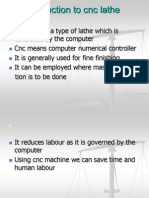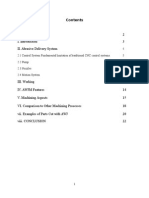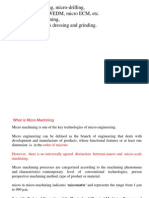Ever Green Machines
Ever Green Machines
Uploaded by
Lisa ParksCopyright:
Available Formats
Ever Green Machines
Ever Green Machines
Uploaded by
Lisa ParksCopyright
Available Formats
Share this document
Did you find this document useful?
Is this content inappropriate?
Copyright:
Available Formats
Ever Green Machines
Ever Green Machines
Uploaded by
Lisa ParksCopyright:
Available Formats
CNC big bore lathe and PVC pipe threading machine
In its simplest form the carriage holds the tool bit and moves it longitudinally (turning) or perpendicularly (facing) under the control of the operator. The operator moves the carriage manually via the handwheel (5a) or automatically by engaging the feed shaft with the carriage feed mechanism (5c). CNC big bore lathe provides some relief for the operator as the movement of the carriage becomes power assisted. The handwheels (2a, 3b, 5a) on the carriage and its related slides are usually calibrated, both for ease of use and to assist in making reproducible cuts. Calibration marks will measure either the distance from center (radius), or the work piece's diameter, so for example, on a diameter machine where calibration marks are in thousandths of an inch, the radial handwheel dial will read .0005 inches of radius per division, or .001 inches of diameter. The carriage typically comprises a top casting, known as the saddle, and a side casting, known as the apron A secondary operation' is a machining operation requiring a partially completed part to be secured in a second machine to complete the manufacturing process. Generally, advanced CAD/CAM software uses live tools in addition to the main spindles so that most parts that can be drawn by a CAD system can actually be manufactured by the machines that the CAD/CAM software support. Carbides pvc pipe threading machine tolerate much higher machining speeds without wearing. This has led to machining times shortening, and therefore production growing. The demand for faster and more powerful lathes controlled the direction of lathe development. A metal lathe or metalworking lathe is a large class of lathes designed for precisely machining relatively hard materials. They were originally designed to machine metals; however, with the advent of plastics and other materials, and with their inherent versatility, they are used in a wide range of applications, and a broad range of materials. In machining jargon, where the larger context is already understood, they are usually simply calledlathes, or else referred to by more-specific subtype names (toolroom lathe, turret lathe, etc.). Pvc pipe threading machine remove material from a rotatingworkpiece via the (typically linear) movements of various cutting tools, such as tool bits and drill bits. The availability of inexpensive electronics has again changed the way speed control may be applied by allowing continuously variable motor speed from the maximum down to almost zero RPM. This had been tried in the late 19th century but was not found satisfactory at the time. Subsequent improvements in electric circuitry have made it viable again.
www.evgreenindia.com/CNC-big-bore-pvc-pipe-threading.html
CNC Lathe Manufacturers
A lathe is a machine tool used principally for shaping pieces of metal, wood, or other materials by causing the workpiece to be held and rotated by the lathe while a tool bit is advanced into the work causing the cutting action. Lathes can be divided into three types for easy identification: engine lathe, turret lathe, and special purpose lathes. Some smaller ones are bench mounted and semiportable. The larger lathes are floor mounted and may require special transportation if they must be moved. Field and maintenance shops generally use a lathe that can be adapted to many operations and that is not too large to be moved from one work site to another. The engine lathe is ideally suited for this purpose. A trained operator can accomplish more machining jobs with the engine lathe than with any other machine tool. Turret lathes and special purpose lathes are usually used in production or job shops for mass production or specialized parts, while basic engine lathes are usually used for any type of lathe work.
Additionally, as many Swiss lathes incorporate a secondary spindle, or 'sub-spindle', they also incorporate 'cnc lathe manufacturers'. Live tools are rotary cutting tools that are powered by a small motor independently of the spindle motor(s). Live tools increase the intricacy of components that can be manufactured by the Swiss lathe. For instance, automatically producing a part with a hole drilled perpendicular to the main axis (the axis of rotation of the spindles) is very economical
with live tooling, and similarly uneconomical if done as a secondary operation after machining by the Swiss lathe is complete. A 'secondary operation' is a machining operation requiring a partially completed part to be secured in a second machine to complete the manufacturing process. Generally, advanced CAD/CAM software uses live tools in addition to the main spindles so that most parts that can be drawn by a CAD system can actually be manufactured by the machines that the CAD/CAM software support. When turning, a piece of relatively rigid material (such as wood, metal, plastic, or stone) is rotated and a cutting tool is traversed along 1, 2, or 3 axes of motion to produce precise diameters and depths. Turning can be either on the outside of the cylinder or on the inside (also known as boring) to produce tubular components to various geometries. Although now quite rare, early lathes could even be used to produce complex geometric figures, even the platonic solids; although since the advent of CNC it has become unusual to use non-computerized toolpath control for this purpose. Hard turning is a turning done on materials with cnc lathe manufacturers a Rockwell C hardness greater than 45. It is typically performed after the workpiece is heat treated.[3] The process is intended to replace or limit traditional grinding operations. Hard turning, when applied for purely stock removal purposes, competes favorably with rough grinding. However, when it is applied for finishing where form and dimension are critical, grinding is superior. Grinding produces higher dimensional accuracy of roundness and cylindricity. In addition, polished surface finishes of Rz=0.3-0.8z cannot be achieved with hard turning alone. Hard turning is appropriate for parts requiring roundness accuracy of 0.5-12 micrometres, and/or surface roughness of Rz 0.87.0 micrometres. It is used for gears, injection pump components, hydraulic components, among other applications.[3] Turning can be done manually, in a traditional form of lathe, which frequently requires continuous supervision by the operator, or by using an automated lathe which does not. Today the most common type of such automation is computer numerical control, better known as cnc lathe manufacturers. (CNC is also commonly used with many other types of machining besides turning.)
www.evgreenindia.com/cnc-lathe-optima_series.html
CNC Machine Retrofitting and CNC Retrofitting Services
Principally retrofitting describes the measures taken in the manufacturing industry to allow new or updated parts to be fitted to old or outdated assemblies (like blades to wind turbines). The production of retrofit parts is necessary in manufacture when the design of a large assembly is changed or revised. If, after the changes have been implemented, a customer (with an old version of the product) wishes to purchase a replacement part then retrofit parts and assembling techniques will have to be used so that the revised parts will fit suitably onto the older assembly.
Another example of this is Cnc machine retrofitting, where older vehicles are fitted with new technologies: power windows, cruise control, remote keyless systems, electric fuel pumps, etc.
The term is also used in the field of environmental engineering, particularly to describe construction or renovation projects on previously built sites, to improve water quality in nearby streams, rivers or lakes. The concept has also been applied to changing the output mix of energy from power plants to cogeneration in urban areas with a potential for district heating. Sites with extensive impervious surfaces (such as parking lots and rooftops) can generate high levels of stormwater runoff during rainstorms, and this can damage nearby water bodies. These problems can often be addressed by installing new stormwater management features on the site, a process that practitioners refer to as stormwater retrofitting. Stormwater management practices used in retrofit projects include rain gardens, permeable paving and green roofs. Additionally, as many Swiss lathes incorporate a secondary spindle, or 'sub-spindle', they also incorporate 'cnc retrofitting services'. Live tools are rotary cutting tools that are powered by a small motor independently of the spindle motor(s). Live tools increase the intricacy of components that can be manufactured by the Swiss lathe. For instance, automatically producing a part with a hole drilled perpendicular to the main axis (the axis of rotation of the spindles) is very economical with live tooling, and similarly uneconomical if done as a secondary operation after machining by the Swiss lathe is complete. A 'secondary operation' is a machining operation requiring a partially completed part to be secured in a second machine to complete the manufacturing process. Generally, advanced CAD/CAM software uses live tools in addition to the main spindles so that most parts that can be drawn by a CAD system can actually be manufactured by the machines that the CAD/CAM software support. When turning, a piece of relatively rigid material (such as wood, metal, plastic, or stone) is rotated and a cutting tool is traversed along 1, 2, or 3 axes of motion to produce precise diameters and depths. Turning can be either on the outside of the cylinder or on the inside (also known as boring)
to produce tubular components to various geometries. Although now quite rare, early lathes could even be used to produce complex geometric figures, even the platonic solids; although since the advent of CNC it has become unusual to use non-computerized toolpath control for this purpose.
www.evgreenindia.com/cnc-machine-retrofitting.html
Gear Hobbing Machine and Polygon Turning Machine
Lathes are used in woodturning, metalworking, metal spinning, Thermal spraying/ parts reclamation, and glass-working. Lathes can be used to shape pottery, the best-known design being the potter's wheel. Most suitably equipped metalworking lathes can also be used to produce most solids of revolution, plane surfaces and screw threads or helices. Ornamental lathes can produce threedimensional solids of incredible complexity. The material can be held in place by either one or twocenters, at least one of which can be moved horizontally to accommodate varying material lengths. Other work-holding methods include clamping the work about the axis of rotation using a chuck or collet, or to a faceplate, using clamps or dogs. For a gear hobbing machine which is a theoretical involute, the fundamental rack is straight-sided, with sides inclined at the pressure angle of the tooth form, with flat top and bottom. The necessary addendum correction to allow the use of small-numbered pinions can either be obtained by suitable modification of this rack to a cycloidal form at the tips, or by hobbing at other than the theoretical pitch circle diameter. Since the gear ratio between hob and blank is fixed, the resulting gear will have the correct pitch on the pitch circle, but the tooth thickness will not be equal to the space width. Most hobs are single-thread hobs, but double-, and triple-thread hobs increase production rates. The downside is that they are not as accurate as single-thread hobs.[9] Depending on type of gear teeth to be cut, there are custom made hobs and general purpose hobs. Custom made hobs are different from other hobs as they are suited to make gears with modified tooth profile. The tooth profile is modified to add strength and reduce size and noise of gears.
In addition to the spindle and its bearings, the headstock often contains parts to convert the motor speed into various spindle speeds. Various types of polygon turning machine mechanism achieve this, from a cone pulley or step pulley, to a cone pulley with back gear (which is essentially a low range, similar in net effect to the two-speed rear of a truck), to an entire gear train similar to that of a manual-shift auto transmission. Some motors have electronic rheostat-type speed controls, which obviates cone pulleys or gears. In addition to the spindle and its bearings, the headstock often contains parts to convert the motor speed into various spindle speeds. Various types ofspeed-changing mechanism achieve this, from a cone pulley or step pulley, to a cone pulley with back gear (which is essentially a low range, similar in net effect to the two-speed rear of a truck), to an entire gear train similar to that of a manual-shift auto transmission. Some motors have electronic rheostat-type speed controls, which obviates cone pulleys or gears. Hobbing is a machining process for making gears, splines, and sprockets on a hobbing machine, which is a special type of milling machine. gear hobbing machine or splines are progressively cut into the workpiece by a series of cuts made by a cutting tool called a hob. Compared to other gear forming processes it is relatively inexpensive but still quite accurate, thus it is used for a broad range of parts and quantities.
www.evgreenindia.com/gear-hobbing-polygon-turning.html
You might also like
- Introduction To CNC LatheDocument18 pagesIntroduction To CNC Lathebest4reverNo ratings yet
- CNC MillingDocument8 pagesCNC MillingNashon Mutua100% (1)
- Motorized Benchh ViseDocument46 pagesMotorized Benchh ViseAlmubeen83% (18)
- Metal SpinningDocument4 pagesMetal SpinningfranklynNo ratings yet
- Roll HANDBOOKDocument12 pagesRoll HANDBOOKMatija RepincNo ratings yet
- Numerical Control - WikipediaDocument14 pagesNumerical Control - Wikipediagudapatimanoj2No ratings yet
- Double Acting Shapper Too LDocument22 pagesDouble Acting Shapper Too LGopuNo ratings yet
- New Microsoft Office Word DocumentDocument10 pagesNew Microsoft Office Word DocumentKamaljeetNo ratings yet
- Studies On The Benefits of Using Linear Motors Insted To Ball Screws Used in Drive of The Machine ToolsDocument8 pagesStudies On The Benefits of Using Linear Motors Insted To Ball Screws Used in Drive of The Machine ToolsVASILIINo ratings yet
- Justifying, Selecting and Implementing Tube Bending Methods: AuthorDocument30 pagesJustifying, Selecting and Implementing Tube Bending Methods: Authorsarge18No ratings yet
- Report 3 MachiningDocument8 pagesReport 3 MachiningHamed ElsayedNo ratings yet
- Numerical Control - Wikipedia, The Free EncyclopediaDocument4 pagesNumerical Control - Wikipedia, The Free EncyclopediazidaaanNo ratings yet
- Turning and Lathe - Guia de Estudo - 2016Document10 pagesTurning and Lathe - Guia de Estudo - 2016Anderson R. RojasNo ratings yet
- Seminar CNC No ReflectionsDocument19 pagesSeminar CNC No Reflectionssettsoumyojjwal9876No ratings yet
- DV09PUB1 Study GuideDocument5 pagesDV09PUB1 Study Guidesbbu agraNo ratings yet
- Tool and Cutter GrinderDocument6 pagesTool and Cutter GrinderNav Srinath100% (1)
- 12 Types of CNC MachinesDocument8 pages12 Types of CNC MachinesVirnic FarmNo ratings yet
- Manual TB6560Document16 pagesManual TB6560erickmoraesNo ratings yet
- Abrasive Water Jet MachiningDocument22 pagesAbrasive Water Jet Machiningpraneeth4aNo ratings yet
- DV09PUB2 Study GuideDocument5 pagesDV09PUB2 Study GuideAmirAmiriNo ratings yet
- Introduction To SectionsDocument10 pagesIntroduction To Sectionssuresh100% (1)
- MillingDocument16 pagesMillingosha0896545No ratings yet
- Internship Main Report FormatDocument25 pagesInternship Main Report FormatGoogle BoTNo ratings yet
- Turning - Wikipedia, The Free EncyclopediaDocument6 pagesTurning - Wikipedia, The Free EncyclopediaKhateeb Ul Islam QadriNo ratings yet
- AUTOMATIC PIPE CUTTING MACHINE EditedDocument25 pagesAUTOMATIC PIPE CUTTING MACHINE EditedrajeshNo ratings yet
- Micro MachiningDocument25 pagesMicro MachiningVishalNaranjeNo ratings yet
- CNC 5 AxisDocument3 pagesCNC 5 AxisJonathan CharanrajNo ratings yet
- Lathe Machine.Document12 pagesLathe Machine.PUBLIC USERNo ratings yet
- Milling and Machining CentersDocument5 pagesMilling and Machining CentersJose JulianNo ratings yet
- Manufacturing Machines and ToolsDocument5 pagesManufacturing Machines and Tools2K18/ME/237 UJJWAL BHARTINo ratings yet
- Duel Side Sapher PDFDocument9 pagesDuel Side Sapher PDFsageetha756No ratings yet
- Samuthra Projects PDFDocument9 pagesSamuthra Projects PDFsageetha756No ratings yet
- 2003 01 PlatesDocument3 pages2003 01 PlatesoioianNo ratings yet
- Maurya Motors AssignmentDocument21 pagesMaurya Motors Assignmentshubham kumar mehtaNo ratings yet
- Machine OperationDocument4 pagesMachine OperationMaster BomboNo ratings yet
- Report ADocument8 pagesReport AFlux PrimeNo ratings yet
- WhitePaper MMTfeatures enDocument3 pagesWhitePaper MMTfeatures enarunNo ratings yet
- CNCLATHEDocument13 pagesCNCLATHEMuhd Akmal0% (1)
- Computer-Aided Manufacturing: Computer-Aided Manufacturing (CAM) Is The Use of Computer Software To ControlDocument4 pagesComputer-Aided Manufacturing: Computer-Aided Manufacturing (CAM) Is The Use of Computer Software To Controlvarma511100% (1)
- Industrial VisitDocument7 pagesIndustrial VisitKandula KrishnarjunNo ratings yet
- CNC MilingDocument10 pagesCNC MilingAbdul HameedNo ratings yet
- Water Jet CuttingDocument11 pagesWater Jet Cuttingosha0896545No ratings yet
- Executive SummaryDocument11 pagesExecutive SummaryNitish Kumar SinghNo ratings yet
- Parts Cut To Length: Ted SlezakDocument8 pagesParts Cut To Length: Ted SlezaksolquihaNo ratings yet
- Seminar CNC No Reflections PDFDocument19 pagesSeminar CNC No Reflections PDFsettsoumyojjwal9876No ratings yet
- Hydraulic RevitingDocument29 pagesHydraulic RevitingDinesh KumarNo ratings yet
- Cmti 1228918957257618 1Document32 pagesCmti 1228918957257618 1Nhan LeNo ratings yet
- Seminar CNC No ReflectionsDocument19 pagesSeminar CNC No Reflectionssettsoumyojjwal9876No ratings yet
- CNC Pure Water Jet Cutting MachinesDocument5 pagesCNC Pure Water Jet Cutting MachinesDarren MadlansacayNo ratings yet
- Tools and Work Holding Devices of CNC MachinesDocument9 pagesTools and Work Holding Devices of CNC Machinessham javed100% (3)
- Module 1 - Machining Science and Jigs & Fixtures (21me42)Document70 pagesModule 1 - Machining Science and Jigs & Fixtures (21me42)Manoj NNo ratings yet
- Career Episode 3: Preparation of Individual Parts Before AssemblyDocument8 pagesCareer Episode 3: Preparation of Individual Parts Before AssemblyHarmeetNo ratings yet
- An Introduction To CNC MachineDocument8 pagesAn Introduction To CNC Machinebulon09No ratings yet
- Reconfigurable Machine Tool: CNC Machine For Milling, Grinding and PolishingDocument7 pagesReconfigurable Machine Tool: CNC Machine For Milling, Grinding and PolishingArif NurhasanNo ratings yet
- Literature ReviewsDocument7 pagesLiterature ReviewsEngineers Gallery100% (2)
- Uses of CNC Lathe MachineDocument3 pagesUses of CNC Lathe MachineKhairul IkhwanNo ratings yet
- MPS5a - GrindingDocument2 pagesMPS5a - GrindingMark julius garciaNo ratings yet
- MillingDocument5 pagesMillingSelan MatlanNo ratings yet
- CS8493 Operating Systems - Unit IDocument24 pagesCS8493 Operating Systems - Unit ILokesh Srm100% (2)
- McTools ShapingDocument2 pagesMcTools ShapingabyzenNo ratings yet
- SDS 239205 en-GBDocument4 pagesSDS 239205 en-GBEldar IsgenderovNo ratings yet
- TC FC + (VC × Q) : Supply ChainDocument3 pagesTC FC + (VC × Q) : Supply ChainJeNo ratings yet
- RPSC Programmer MCQ 2Document15 pagesRPSC Programmer MCQ 2Vikas SinghalNo ratings yet
- Final Year Project Presentation On Riko: The Adventurer: Supervised byDocument19 pagesFinal Year Project Presentation On Riko: The Adventurer: Supervised byMuhammad Farhan Saiful AzmanNo ratings yet
- A Practical ISO9001-2000 Course OutlineDocument3 pagesA Practical ISO9001-2000 Course OutlinenorlieNo ratings yet
- Oracle Fleet Management PDFDocument3 pagesOracle Fleet Management PDFRiyaz RasperNo ratings yet
- Munir Azam Muhammad-ResumeDocument3 pagesMunir Azam Muhammad-ResumemunirsweetNo ratings yet
- Young Engineering Consultancy Services: General NotesDocument7 pagesYoung Engineering Consultancy Services: General NotesAizhar John QuindozaNo ratings yet
- LogDocument9 pagesLogMichelle EndrinaNo ratings yet
- Mind Mapping: Survival GuideDocument2 pagesMind Mapping: Survival GuideRajManNo ratings yet
- FMB Devices AVL ReferenceDocument121 pagesFMB Devices AVL ReferenceSasa AhlanNo ratings yet
- Ledmall Optonica New Arrivals Solar Products 2023Document24 pagesLedmall Optonica New Arrivals Solar Products 2023dridarthNo ratings yet
- Andritz VA TECH HYDRO GFSE-Presentation Harald SchmidDocument18 pagesAndritz VA TECH HYDRO GFSE-Presentation Harald SchmidArief IhsanNo ratings yet
- Digital LibraryDocument13 pagesDigital LibraryJean GagalacNo ratings yet
- Thermoking T-1000R - Spec - SheetDocument2 pagesThermoking T-1000R - Spec - SheetM Miftakh100% (1)
- Lab NetworkDocument99 pagesLab Networkahmed raedNo ratings yet
- Oracle® Demantra Predictive Trade Planning: User's Guide Release 7.3Document284 pagesOracle® Demantra Predictive Trade Planning: User's Guide Release 7.3Hisham ZakiNo ratings yet
- HVDC Light PaperDocument11 pagesHVDC Light Papersat1591No ratings yet
- Bachelor of Science Information Technology MinDocument2 pagesBachelor of Science Information Technology MinYoyo ManuNo ratings yet
- Circuit Diagram SAMSUNG GALAXY J200GUDocument7 pagesCircuit Diagram SAMSUNG GALAXY J200GUSathish RajanNo ratings yet
- Oasis ManualDocument9 pagesOasis ManualKuladeepa KrNo ratings yet
- Retail Banking: Challenges Ahead in Distribution Channels in Urban/Rural IndiaDocument3 pagesRetail Banking: Challenges Ahead in Distribution Channels in Urban/Rural IndiaAbhay AaryanNo ratings yet
- Building Chatbots in Python Chapter2 PDFDocument41 pagesBuilding Chatbots in Python Chapter2 PDFFgpeqwNo ratings yet
- Multi - Function ValveDocument2 pagesMulti - Function Valvera5tr@No ratings yet
- Lecture15 18022020Document16 pagesLecture15 18022020Parekh Prashil BhaveshbhaiNo ratings yet
- Dokumen - Tips Opentext-VimDocument7 pagesDokumen - Tips Opentext-VimAnil ReddyNo ratings yet
- Imc-21 Series: Entry-Level Industrial 10/100baset (X) To 100basefx Media ConvertersDocument3 pagesImc-21 Series: Entry-Level Industrial 10/100baset (X) To 100basefx Media ConvertersDamjan BabicNo ratings yet
- Chapter 2 - IT Essentials - PC Hardware & SoftwareDocument5 pagesChapter 2 - IT Essentials - PC Hardware & Softwaretrim-k100% (2)

























































































